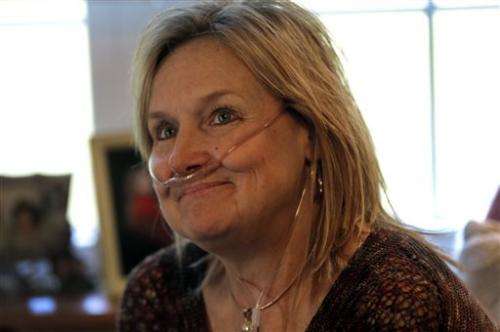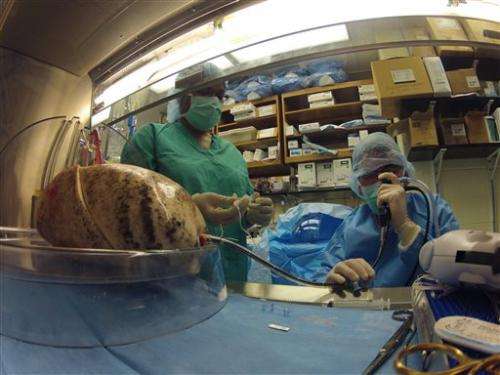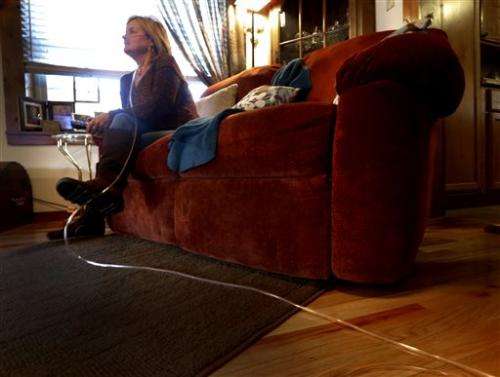Seeking lung donors after at-home death

The pair of lungs sits inside a clear dome, gently inflating as doctors measure how well they'll breathe if implanted into a patient who desperately needs them.
It's a little-known twist of nature—your lungs can live on for a while after you die. The air left inside keeps them from deteriorating right away as other organs do.
An innovative experiment aims to use that hour-or-more window of time to increase lung transplants by allowing donations from people who suddenly collapse and die at home instead of in a hospital.
"There aren't enough lungs. We're burying them," said Dr. Thomas Egan of the University of North Carolina, Chapel Hill, who is leading the project. "It turns out your lungs don't die when you do."
This is a new frontier for transplants.
Today, registered organ donors don't get to fulfill that last wish if they die outside of a hospital. The U.S. doesn't have a system to recover their organs quickly enough
"The general public does not understand how hard it is to become an organ donor. They assume if they sign their card, when they die, then it will happen," said bioethicist Arthur Caplan of New York University's Langone Medical Center. "Only 2 to 3 percent of people die in circumstances that let them be organ donors."
The new study is trying to change that, focusing on lungs because Egan's research suggests they last the longest.
Here's how it works.
Someone collapses with cardiac arrest. Emergency workers exhaust attempts at CPR. If the driver's license lists the person as a registered donor, the local organ recovery agency tracks down next-of-kin for permission to participate in the research.

If that happens within about an hour of death, then workers pump a little air into the lungs to preserve them while the body is transported to an operating room for organ recovery.
Inside the domed machine, a ventilator slowly filled the lungs. Egan infused them with a special fluid that flows like blood normally would. This preserves the lungs even longer. Egan peeked inside with a bronchoscope, looking for abnormalities.
These lungs didn't pass the test because Egan found some early disease.
Lungs that do pass will be transplanted into patients willing to take a chance on these nontraditional organs, as part of the study funded by the National Institutes of Health.
Transplant specialists are watching this newest experiment closely, saying that if it works, it eventually could open the way to many more donations—not just lungs but maybe other organs, too.
Dr. Jeffrey Punch, transplant surgery chief at the University of Michigan, plans with his team to try recovering kidneys from cardiac arrest victims who are rushed to the emergency room but can't be saved and turn out to be registered donors.
Today, the vast majority of donated organs come from people who suffer a severe injury and are hooked to a ventilator for days, even weeks, until doctors determine they are brain-dead. Machinery keeps blood and oxygen flowing until surgeons can collect organs deemed healthy enough.
In the United States, more than 6,000 people died last year while awaiting one of those organs.

Lungs are in particularly short supply. Only 15 percent to 20 percent of donated lungs are usable, often because complications during the donor's hospitalization damaged them. Just 1,700 lungs transplants are performed each year, compared with nearly 11,000 kidney transplants from deceased donors.
In a series of experiments with animals, Egan showed lungs stay viable for an hour, or four hours if they are ventilated, before they're cooled to await transplant.
That ventilation is one key to the $4 million, three-year study, because when emergency workers exhaust attempts at CPR and declare someone dead, they typically leave behind the breathing tube inserted in the person's throat. That makes it simple to restart ventilation to preserve the lungs, Egan said.
"If we can get the lungs ventilated within an hour, and then removed within an hour or two and cooled, we think they'll work just fine," he said.
Kidneys don't have as long a survival window. But in Michigan, Punch has a similar preservation plan: Insert a few tubes near the kidneys to filter blood to them until they're recovered.
© 2013 The Associated Press. All rights reserved.

















